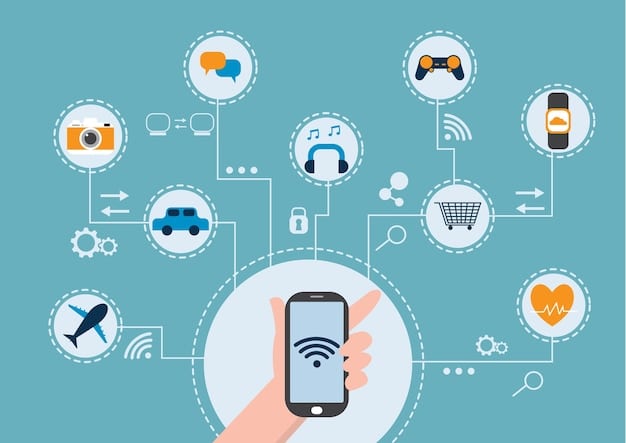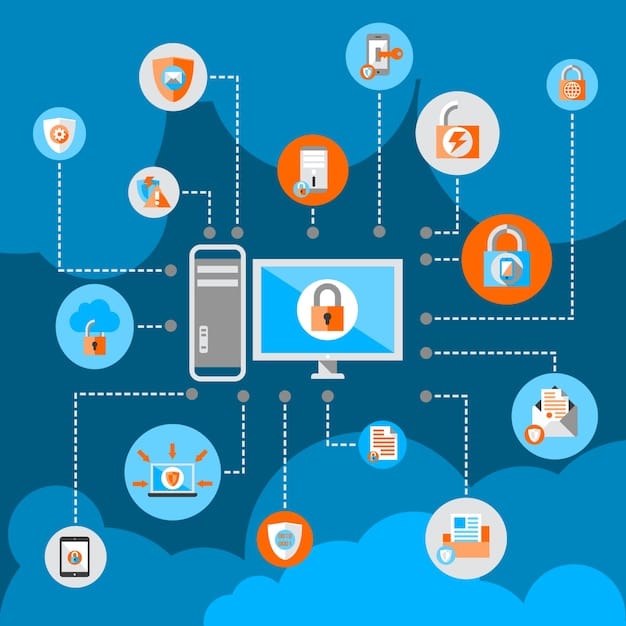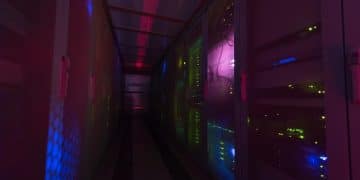The Impact of 5G Expansion on IoT Innovation in the US Market

The Impact of 5G Expansion on IoT Innovation in the US Market is significant, enabling faster data transfer, lower latency, and increased device connectivity, fostering advancements in smart cities, autonomous vehicles, and healthcare.
The advent of 5G technology is poised to revolutionize various sectors, and the Internet of Things (IoT) is no exception. In the US market, the impact of 5G expansion on IoT innovation is already becoming apparent, promising unprecedented advancements and opportunities.
This article explores the multifaceted ways in which 5G is reshaping the IoT landscape, from enhancing connectivity to enabling new applications and business models.
Understanding the Basics: 5G and IoT
Before diving into the specifics, it’s crucial to understand what 5G and IoT entail and how they differ from previous technologies.
What is 5G?
5G is the fifth generation of wireless technology, designed to offer faster speeds, lower latency, and greater capacity compared to its predecessors. This means quicker downloads, more responsive applications, and the ability to connect a larger number of devices simultaneously.
What is IoT?
The Internet of Things (IoT) refers to the network of physical devices, vehicles, home appliances, and other items embedded with electronics, software, sensors, and network connectivity that enables these objects to collect and exchange data.
Together, 5G and IoT create a powerful synergy that unlocks new possibilities across industries. The enhanced capabilities of 5G address many of the limitations that have previously hindered the widespread adoption of IoT.
In conclusion, 5G’s improved speed, latency, and capacity, combined with the increasing prevalence of IoT devices, pave the way for significant innovation and transformation in the US market.
The Technical Advantages of 5G for IoT
The technical superiority of 5G over previous generations of wireless technology brings several key advantages that directly benefit IoT applications.
Enhanced Bandwidth and Speed
5G offers significantly higher bandwidth and speeds compared to 4G LTE. This enables IoT devices to transmit and receive large amounts of data quickly and efficiently, crucial for applications such as high-definition video surveillance and real-time analytics.
Ultra-Low Latency
Latency is the delay between sending and receiving data. 5G dramatically reduces latency, making it possible for IoT devices to respond almost instantaneously. This is particularly critical for applications like autonomous vehicles and remote surgery, where even a slight delay can have serious consequences.
Increased Device Density
5G networks can support a much higher density of connected devices per square kilometer compared to 4G. This is essential for IoT deployments in densely populated areas, such as smart cities and industrial facilities, where numerous devices need to be connected and communicate simultaneously.
These technical advantages collectively contribute to more reliable, efficient, and capable IoT solutions, driving innovation across various sectors. The impact of 5G expansion on IoT innovation is evident in the new possibilities it unlocks for data-intensive and real-time applications.
In summary, 5G’s bandwidth, low latency, and device density improvements are foundational for next-generation IoT applications, ensuring seamless and reliable operation.

Key Industries Benefiting from 5G-Enabled IoT
Numerous industries stand to gain from the integration of 5G and IoT, each with its unique set of applications and benefits.
- Smart Cities: 5G enables smarter traffic management, optimized energy consumption, and enhanced public safety through connected sensors and surveillance systems.
- Healthcare: Remote patient monitoring, telemedicine, and robotic surgery become more reliable and efficient with 5G’s low latency and high bandwidth.
- Manufacturing: 5G-enabled IoT solutions improve automation, predictive maintenance, and real-time monitoring of equipment, leading to increased productivity and reduced downtime.
- Automotive: Autonomous vehicles rely on 5G for reliable communication with infrastructure and other vehicles, ensuring safe and efficient navigation.
Examining the Transformative Potential
5G-enabled IoT is not just about improving existing processes; it’s about enabling entirely new business models and services. For example, in agriculture, 5G-connected sensors can monitor soil conditions, weather patterns, and crop health in real-time, allowing farmers to optimize irrigation, fertilization, and pest control, leading to higher yields and reduced costs.
In logistics, 5G and IoT can provide end-to-end visibility of the supply chain, from the factory floor to the customer’s door. This allows for better inventory management, reduced losses, and faster delivery times.
From enhancing operational efficiency to creating new revenue streams, the impact of 5G expansion on IoT innovation is transforming industries across the US market.
Ultimately, 5G’s advanced capabilities enhance a wide range of sectors, fostering efficient operations and novel business models.
Challenges and Considerations for 5G and IoT Deployment
While the potential of 5G and IoT is immense, there are several challenges and considerations that need to be addressed to ensure successful deployment.
Security Concerns
The increased connectivity and data exchange brought about by 5G and IoT also create new security vulnerabilities. Protecting IoT devices and networks from cyberattacks is crucial, requiring robust security measures such as encryption, authentication, and intrusion detection systems.
Privacy Issues
The collection and use of data generated by IoT devices raise significant privacy concerns. Ensuring that data is collected and used in a transparent and ethical manner, with appropriate safeguards in place to protect individuals’ privacy, is essential for building trust and fostering adoption.
Interoperability
Ensuring that different IoT devices and systems can communicate and work together seamlessly is a major challenge. Standardization efforts and open protocols are needed to promote interoperability and avoid vendor lock-in.
Addressing these challenges requires a collaborative effort involving governments, industry players, and researchers. By working together, we can mitigate the risks and unlock the full potential of 5G and IoT.
Overall, addressing the security, privacy, and interoperability hurdles is critical for the successful integration of 5G and IoT technologies.

The Future of 5G and IoT in the US Market
Looking ahead, the future of 5G and IoT in the US market is bright, with numerous exciting developments on the horizon.
As 5G networks continue to expand and mature, we can expect to see even greater adoption of IoT solutions across industries. This will drive further innovation and create new opportunities for businesses and consumers alike.
Moreover, advancements in artificial intelligence (AI) and machine learning (ML) will further enhance the capabilities of 5G and IoT, enabling more intelligent and autonomous systems. For example, AI-powered analytics can process the vast amounts of data generated by IoT devices to identify patterns, predict outcomes, and optimize performance.
The impact of 5G expansion on IoT innovation will be amplified by edge computing, which brings processing power closer to the edge of the network, reducing latency and improving responsiveness. This is particularly important for applications that require real-time decision-making, such as autonomous robots and augmented reality.
Ultimately, the convergence of 5G, IoT, AI, and edge computing will create a powerful platform for innovation, transforming industries and improving the lives of people across the US market.
To conclude, the synergistic relationship between 5G and IoT, coupled with advances in AI and edge computing, presents a promising outlook for future innovations and market transformations.
| Key Point | Brief Description |
|---|---|
| 🚀 Increased Speed | 5G offers faster data transfer rates for IoT devices. |
| 💡 Lower Latency | 5G reduces delays in IoT device communication. |
| 🌐 Higher Capacity | 5G supports more connected IoT devices. |
| 🛡️ Enhanced Security | 5G improves IoT security against cyber threats. |
Frequently Asked Questions (FAQ)
5G enhances IoT device connectivity by providing faster speeds, lower latency, and greater capacity, enabling more devices to connect simultaneously and transmit data efficiently, fostering the impact of 5G expansion on IoT innovation.
The main challenges include security concerns, privacy issues, and interoperability problems. Ensuring robust security, protecting user privacy, and promoting seamless communication between devices are crucial for successful deployment.
Businesses can use 5G-enabled IoT solutions for real-time monitoring, predictive maintenance, and automation, leading to increased productivity, reduced downtime, and optimized resource utilization, significantly enhancing operational efficiency.
AI enhances 5G-enabled IoT systems by providing intelligent analytics, pattern recognition, and predictive capabilities. This enables more autonomous and optimized systems, improving decision-making and overall performance.
The future prospects are promising, with expectations of greater adoption of IoT solutions, driven by the expansion of 5G networks. This convergence will foster innovation and create new opportunities across various sectors, contributing to economic growth.
Conclusion
In conclusion, the synergy between 5G and IoT holds immense potential for transforming industries and enhancing daily life in the US market. The impact of 5G expansion on IoT innovation is already evident, with advancements in smart cities, healthcare, manufacturing, and automotive sectors.
Addressing the challenges of security, privacy, and interoperability will be crucial for unlocking the full potential of this transformative technology. By working together, governments, industry, and researchers can pave the way for a smarter, more connected future.





